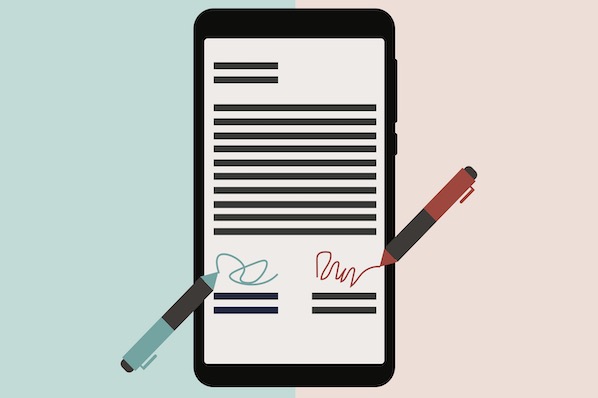Electronic signatures and the law in India
Many times, we come across documents and .pdf files that are electronically signed (e-sign) and authenticated by the corresponding authority. In this article, we will learn about e-signatures, how to e-sign documents, who authorizes e-signatures, and what is the Indian law on electronic signatures. People sign bank statements, credit card statements, form 16 (TDS) of Income Tax Act provided by the employer, etc. For the uninitiated, it may look something like this.

What do we mean by Electronic Signature?
When you ‘authenticate’ an electronic record by ‘electronic techniques’, Section 2(1) (ta) of the Information Technology Act, 2000 defines it as an ‘electronic signature’.
If you have ever come across someone inserting an image or a symbol into a document, you have seen an Electronic Signature or E-sign. It is more of assent on the given document or a mark of verification. You can do it by inserting a copy of your signature electronically into the document.
“Digital Signatures are electronic signatures, but electronic signatures are not digital signatures.”
Interestingly, digital signature and other techniques as specified in the 2nd schedule of the Act, are a subset of electronic signature- albeit they use different technologies and have different characteristics. Hence, it would be safe to say that a digital signature is also a type of electronic signature. But, an electronic signature is less secure than a digital signature. It can be tampered with and cannot be easily verified with regard to time and place.
What is the law on electronic signature?
India has recognized digital signatures since the implementation of the IT act 2000. Gradually, by 2009, other forms of electronic signatures also made it to the mainstream. Hence, in 2009, an amendment to Act inserted Section 3A- recognizing electronic signatures.
However, the language follows a technology-neutral strategy while specifying electronic signature. I’ll explain. Section 3, which deals with digital signatures, mandates that a digital signature must use an asymmetric crypto-system and hash function. But, Section 3A doesn’t specify any particular technological process for electronic signatures.
It is important to note that an electronic signature can be in any form such as a name typed at the end of the email, or an image of a handwritten signature in the form of an attachment, or a code, or even a fingerprint. However, an e-signature has to be verified through the signer’s identity for e.g., Aadhar Card.
Legal Validity of electronic signatures
Although Section 3A does not lay down any specific technological requirements, it does say that the technique used must be considered reliable ‘and’ may be ‘specified in the Second Schedule’. However, till date, the second schedule remains blank. The government has not notified any electronic authentication technique to authenticate electronic records.
How do you get an e-sign on a Document?
There are multiple ways to sign a document using an electronic signature. To name a few, you can add your name, pictures, symbols to a document. You can use different applications to apply your electronic signature on any online document by authenticating your identity.
The ‘authenticating your identity’ part is important to note here. Electronic signatures work on the theory that the signature authenticates the signer’s identity and that the signer approved the content of the electronic record, which was successfully verified by the recipient of that record.
In India, you can authenticate your identity using your Aadhaar ID. While signing the document, you will need to enter an OTP (One Time Password). Applications make use of this process using the e-KYC service. Online e-service providers (like Adobe) also work with accredited service providers (like e-mudra for Adobe).
Online e-service providers like Adobe.com, smallpdf.com, emsigner.com, etc. provide e-sign facilities through e-KYC authentication models. A user can identify herself through the verification of Aadhar or PAN card details. The user will receive an OTP for verification, which will give out an E-signature code.
To put the electronic signature on a document, the service provider would ask for the symbol/ signature mark, the document which is to be signed, and the E-signature code. Every time the users want to sign a document, she will receive an OTP on her phone to authenticate the signature.
Electronic signatures and the law of evidence?
Section 67A of the Indian Evidence Act, 1872 lays down that in the event of alleging someone’s e-signature on a document, the alleger needs to prove that the e-signature indeed belongs to the subscriber.
Such liability, however, does not arise in the case of secure electronic records and secure electronic signatures. So, what exactly is a ‘Secure Electronic Signature’?
It can be safely said that only a digital signature is a secure electronic signature. Section 85B talks about presumption as to electronic records and electronic signatures. Section 85(B) clearly says that the presumption shall prevail only if the proceedings involve a ‘secure digital signature’.
What legal papers you cannot sign using electronic signatures?
Now that you know how to e-sign a document, let’s quickly have a look at what things you cannot sign using an electronic signature. Unfortunately, Section 1(4) of the IT Act, 2000 (read with the First Schedule), excludes the following legal documents or instruments from the purview of the Act:
- a negotiable instrument as defined in section 13 of the Negotiable Instruments Act, 1881;
- a power-of-attorney as defined in section 1A of the Powers-of-Attorney Act, 1882;
- a trust as defined in section 3 of the Indian Trusts Act, 1882;
- a will as defined in clause
- any contract for the sale or conveyance of immovable property or any interest in such property;
- any such class of documents or transactions as may be notified by the Central Government in the Official Gazette.
This article was co-authored by Rohit Ranjan Praveer and edited by Debdatta Das, a 5th-year law student at Ajeenkya D Y Patil University.
Do subscribe to our Telegram channel for more resources and discussions on tech-law. To receive weekly updates, don’t forget to subscribe to our Newsletter.

